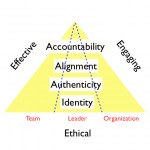We are conditioned to wanting a Standard and Poor’s “AAA” or Moody’s “Aaa” rating, those agencies’ highest level of confidence that organizations can repay their debt. Those traditional ratings are lagging indicators, however, after-the-fact reflections of what organizations have or have not done to earn them. I encourage you to strive for “EEE” ratings, indicators that you are effective (achieve your goals,) engaging (a desirable place to work) and ethical (high integrity, and a good community citizen.) “EEE” ratings are leading indicators of overall organizational health and excellent predictors of traditional rating agencies’ scores. Logically, organizations that achieve their strategic and financial goals are better positioned to repay debt, there is adequate evidence that high engagement scores correlate with profitability, and we have certainly witnessed our share of organizations that failed on account of ethical shortcuts.
How does an organization earn a triple-E rating? The good news is that a handful of high-leverage practices will boost all three “Es:” organization effectiveness, worker engagement and ethical cultures. My research and experience working with dozens of organizations over three decades yielded four sets of practices that distinguish Triple-E organizations:
IDENTITY – Triple-E organizations know who they are, what they value and where they are going; they are clear about their “3 Ps:”
- They know their purpose, and their purpose resonates with employees and customers.
- They know what they stand for; in words and more importantly deeds, they are committed to their principles.
- They are clear about their priorities; organization members understand their strategy and priority goals.
They are also keenly aware of their strengths and their vulnerabilities; they leverage their strengths and are less likely to fail on account of weaknesses that they’ve overlooked.
AUTHENTICITY – They are “true,” truth-telling and transparent.
- They remain true to their purpose, principles and priorities; members and stakeholders don’t hear one thing but see different behavior.
- They are well-attuned to marketplace and organizational realities, and are straight communicators.
- Information is readily accessible by those who need it; financial statements are clear and easily understandable.
ALIGNMENT – There is tight fit of organizational systems and practices with purpose, principles and priorities, balanced by adaptability.
- Structure, systems, people and practices reinforce the organization’s purpose, principles and priorities.
- There is a general sense of unity and “fit;” organizational parts compose a coherent whole.
- Unity is not confused with sameness, and alignment does not get in the way of constructive change and growth.
ACCOUNTABILITY – We can count on them to keep their promises, they measure what matters, and exercise responsible stewardship.
- As big as brand promises and strategic objectives, or as small as returning calls when promised, we can count on them to honor their commitments.
- They keep track of what counts; measures are useful and balanced, reflecting impact on profit, people and planet.
- They are responsible stewards of resources near and far.
Organizations and leaders that exhibit these characteristics attract the best talent, have what it takes to succeed in the marketplace long-term, and are least likely to become ethically compromised. As you scan the list above you can likely make direct connections between each characteristic and how it drives effective, engaging or ethical cultures, or all three simultaneously. Consider IDENTITY’s “3 Ps,” for example for example. We will likely be more engaged affiliated with an organization and doing work with a meaningful purpose. If that organization clearly communicates its strategy and priority goals, there is a higher likelihood that we will execute the strategy, achieve priority goals and succeed in the marketplace. Ethical failures are often the result of organizations or leaders that are not clear about their principles. Failures in all four dimensions that comprise the triple-e framework drove our latest and great recession, and impacted all three “Es.”

Webster’s first definitions for “integrity” are about being whole, complete and unbroken – essentially what the triple-e framework and ratings add up to. Triple-e organizations and leaders are complete because they are attuned to all three dimensions of what Howard Gardner calls “Good Work” in his book by that same name; they pay attention to the whole picture. Think of a three-legged stool; organizations and leaders with a missing or weak “leg” are sure to fail sooner than later.
“EEEs” four dimensions constitute inTEgro’s Leadership and Organizational Integrity Model and the main themes in my book Navigating Integrity – Transforming Business As Usual Into Business At Its Best. Consistent with ACCOUNTABILITY’s “measuring what matters,” inTEgro offers the Organizational Integrity Survey – a 40-item survey to help organizations get a fix on where they are with each dimension, and the Leadership Integrity Survey – a 40-item self-survey for individual leaders to do the same. More information on both surveys can be found at http://www.integro-inc.com/services/survey_products.
I would like to hear how this perspective squares with your experience of what constitutes organizational and leadership excellence. The first three who respond will receive a signed copy of my book Navigating Integrity . . . as well as a code for taking the Leadership Integrity Survey free online.
Best wishes in your efforts to earn a EEE rating!
“Be really whole and all things will come to you.”
Lao-Tzu
“Integrity is the cornerstone of free enterprise, and all leaders need a clear teachable point of view on it.”
Noel Tichy
